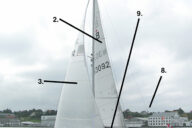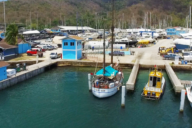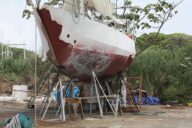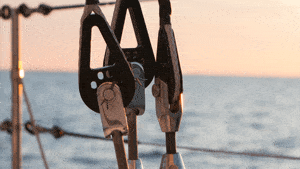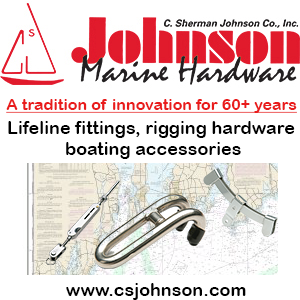Capt. John of skippertips.com introduces his valuable tips for docking when short handed.
If you sail short- or single-handed there will be times when longer docking lines just will not do. Or perhaps you need to keep the sailboat as close to the pier as possible to load provisions or guests. Here’s an intro to one of the best-kept secrets in all of docking. Read on to discover the pros and cons of this “secret weapon” of sailing.

Use a breast line (red) to hold your boat tight alongside a pier for boarding or provisioning. Make sure to use the steps described below to protect your boat from expensive damage.
You might have been in a situation where you needed a short, temporary line to hold your boat close alongside a pier. Enter the breast line. Think of a perpendicular line formed with the centerline (red line in the illustration above). Before you load provisions or crew, run a short length of line near the beam at about a 90° angle to the keel. Remove all slack and cinch it tight.
Now your boat will stay tight against the pier without any movement. This will be even more useful in exposed piers with ground swell, wave action or cantankerous boaters who refuse to control their wake. But before you use a breast line, follow the steps below.
How to Avoid “Hanging” Your Boat
More than one boat has been left with breast lines–or lines similar to breast lines–unattended. The owner returns after a night on the town or a long absence to find his or her boat “hanging” on a deck fitting.
In tidal areas, your boat will take a strain on the shortest dockline. And, if you used a breast and forgot to remove it, your vessel will hang on this single line. That could result in expensive damage to deck and hull fittings. Remove the breast line as soon as you are done.

If you go ashore, relocate the breast line (red) to a pier cleat or piling at the far end of the pier (top illustration). When you return to the boat, untie the breast line, pull in the boat, cleat off the breast line, and board the boat (middle illustration). Move the breast line to a fore or aft boat cleat. Leave lots of slack to allow for tidal changes (bottom illustration). See details below.
But what if you need to lay ashore for provisions or a night on the town? A strong off-the-dock wind or current pushes your boat off the pier. When you return, you will need a breast line to bring the boat alongside the pier for boarding. Use the illustrations above along with the steps described below.
After you lay ashore, move the breast line to a pier cleat or piling on the far side of the pier (top illustration). That way, the line will allow your boat to rise and fall with the tide. Leave a lot of slack in the breast line so that it does not come under strain.
When you return to the boat, untie the breast line. Pull the boat flush alongside the pier and cleat off the breast line to the original pier cleat located adjacent to your beam (middle illustration). Board the boat. Untie the breast line from your boat beam cleat. Move the breast line to a bow or stern cleat (bottom illustration). Leave a lot of slack in the breast line so that it does not come under strain.
~~~~~~~~~~~~~~~~~~~~~
Use these sailing tips to help make provisioning and boarding safer and easier for you and your sailing crew or guests. This will put you in control on the waters of the world–wherever you choose to sail or cruise!



